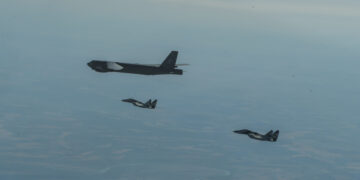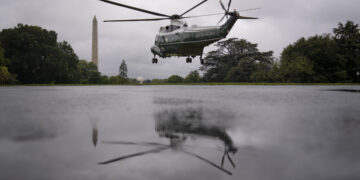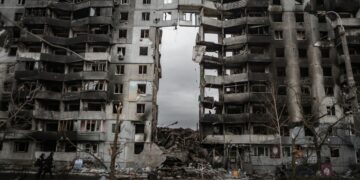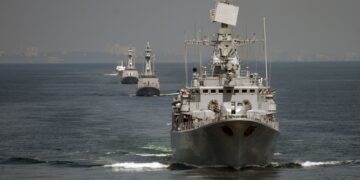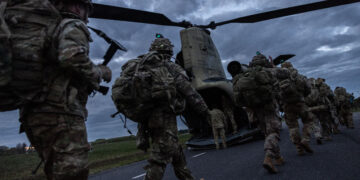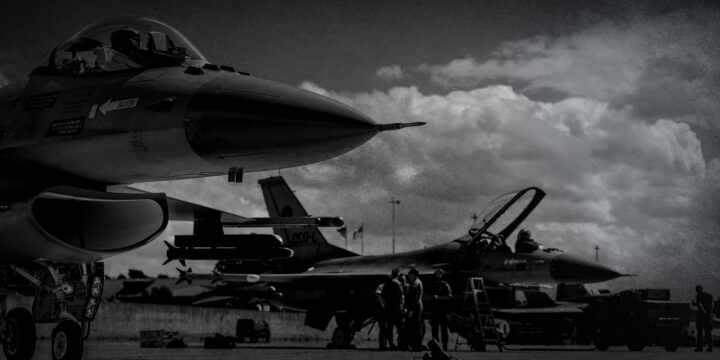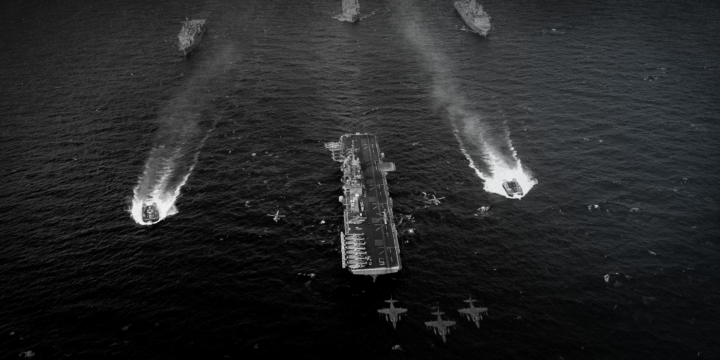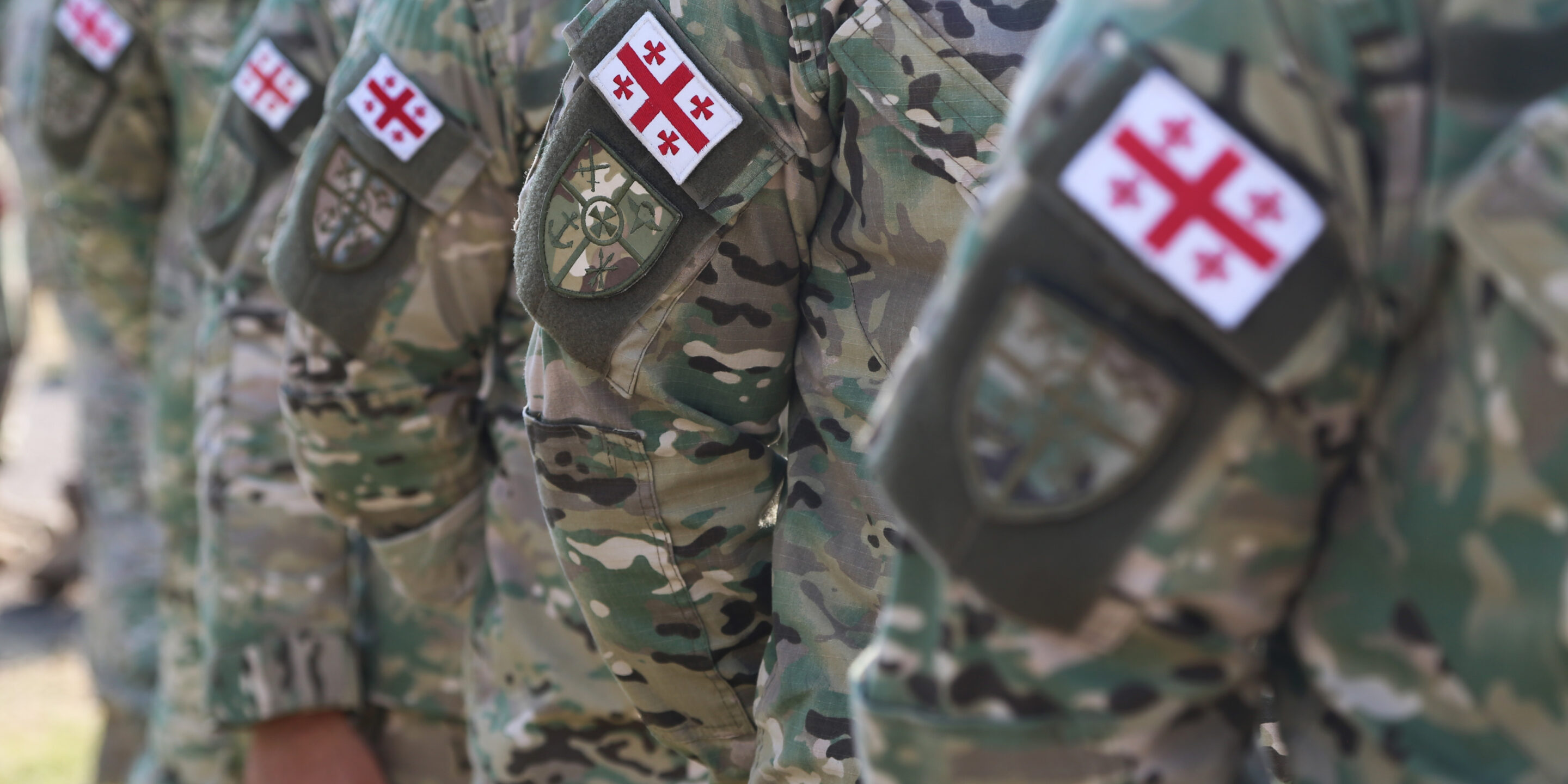
Key points
- A central question of Georgian membership in NATO must be whether the alliance can reasonably expect to defend it through conventional means. A number of factors—including Georgia’s precarious geographic position, its small size, and the presence of Russian forces on its territory—argue that it cannot.
- Even without additional reinforcements, Russia’s Southern Military District enjoys significant advantages over Georgia in armored vehicles and artillery. It also would have overwhelming dominance in the air. Georgia has almost no air force to speak of and only limited air defenses.
- Realistic assessments of Georgia’s defensibility must take into consideration Turkey’s increasingly independent foreign policy and mercurial relationship with NATO. Turkey would be essential to Georgia’s reinforcement by land and also could dictate naval access to Georgia via its control of the Bosporus and the Dardanelles.
- Despite the significant risk the United States would take on by extending its nuclear umbrella to protect Georgia, there are no clear and overwhelming strategic advantages its addition to NATO would offer.
Georgian membership in NATO remains an open question. The issue received renewed focus early in 2021, during Antony Blinken’s confirmation hearing for secretary of state. In response to a question from Sen. Rand Paul on future enlargement of NATO, Blinken stated, “If a country like Georgia is able to meet the requirements of membership, and if it can contribute to our collective security, yes, the door should remain open.”1See the exchange beginning at 2:46:30 in U.S. Senate Committee on Foreign Relations, “Secretary of State Confirmation Hearing,” C-SPAN, January 19, 2021, https://www.c-span.org/video/?507953-1/secretary-state-nominee-antony-blinken-testifies-confirmation-hearing.
Blinken’s two criteria—meeting NATO membership requirements and contributing to collective security—are an important baseline for weighing Georgia’s candidacy. But as the alliance’s most important member and ultimate guarantor through its nuclear arsenal, the United States must expand its scope in assessing whether to continue support for Georgia’s accession goal.2It has been standing U.S. and NATO policy that Georgia will join the alliance since the 2008 Bucharest Summit, though a timetable has never been established and Georgia has never been issued a Membership Action Plan (MAP), i.e., a specific technical roadmap for joining NATO. North Atlantic Treaty Organization, “Bucharest Summit Declaration,” Issued by the Heads of State and Government participating in the meeting of the North Atlantic Council in Bucharest on April 3, 2008, https://www.nato.int/cps/en/natolive/official_texts_8443.htm. First, the United States must ask if there is a reasonable prospect of defending the country exclusively through conventional means. If the answer is yes, the threshold for what Georgia would contribute to U.S. security is arguably lower.
But if there is not a reasonable prospect of a conventional defense, the only alternative for NATO in protecting Georgia is reliance on nuclear threats and even, conceivably, nuclear use in the event of Russian invasion. Under those circumstances, the bar for Georgia’s importance is much higher. This leads to a second essential question: Is there anything Georgia offers U.S. security or interests that warrants the extension of its nuclear umbrella and the attendant risks? Answering these questions necessitates a clear understanding of the military requirements protecting Georgia entails and the nature of its overall threat environment.
Soviet legacies: Abkhazia and South Ossetia
Much about Georgia’s current security situation is rooted in the circumstances that obtained after the fall of the Soviet Union. Georgia emerged as an independent state, but one without full sovereignty over its territory. Three provinces—Abkhazia, Adjara, and South Ossetia—resisted central control by Tbilisi. All had been autonomous regions within the USSR (similar to Chechnya in Russia itself).
Each had its own regional capital and exercised de facto sovereignty over large portions of its territory. Adjara, in the southwest on the Turkish border, was eventually brought to heel in 2004. The combination of protests within the province against local autocrat Aslan Abashidze and military threats from Tbilisi forced Abashidze’s departure and led to Adjara’s loose incorporation into the broader Georgian state.3“Can Saakashvili Repeat Adjar Success?” Radio Free Europe/Radio Liberty, May 25, 2004, https://pressroom.rferl.org/a/1105704.html; Nick Paton Walsh and Natalia Antelava, “Adzharian Leader Flees Georgia, Says President,” The Guardian, May 5, 2004, https://www.theguardian.com/world/2004/may/06/georgia.nickpatonwalsh.
Abkhazia and South Ossetia, in the north abutting Russia, proved more difficult. Unlike Adjara, the Georgian government had initially tried to placate the northern separatists by force. The ensuing wars in the early 1990s were ugly stalemates and led to the deployment of Russian peacekeepers in both territories.4In the case of South Ossetia, its separatist movement had sparked a military response from Tbilisi even before the final Soviet collapse. The two sides fought a brutal but inconclusive war from 1991 to 1992. Abkhazia asserted its independence shortly after the fall of the USSR, leading to the 1992–93 Abkhaz-Georgian war. Abkhazia and South Ossetia have functioned as independent quasi-states since, with essential military and financial backing from Moscow.
This is a point worth dwelling on. Both regions have now lived outside Tbilisi’s control for nearly three decades. This is not to defend their current status or Russia’s role in fostering it. But it is to emphasize that even if Georgia were somehow to establish control over these territories, integration would be neither swift nor easy. Abkhazia and South Ossetia are dominated by eponymous ethnic groups who are distinct from Georgians. Intercommunal violence has characterized their conflicts with the central government.
Southern Military District bases in Armenia and Georgia
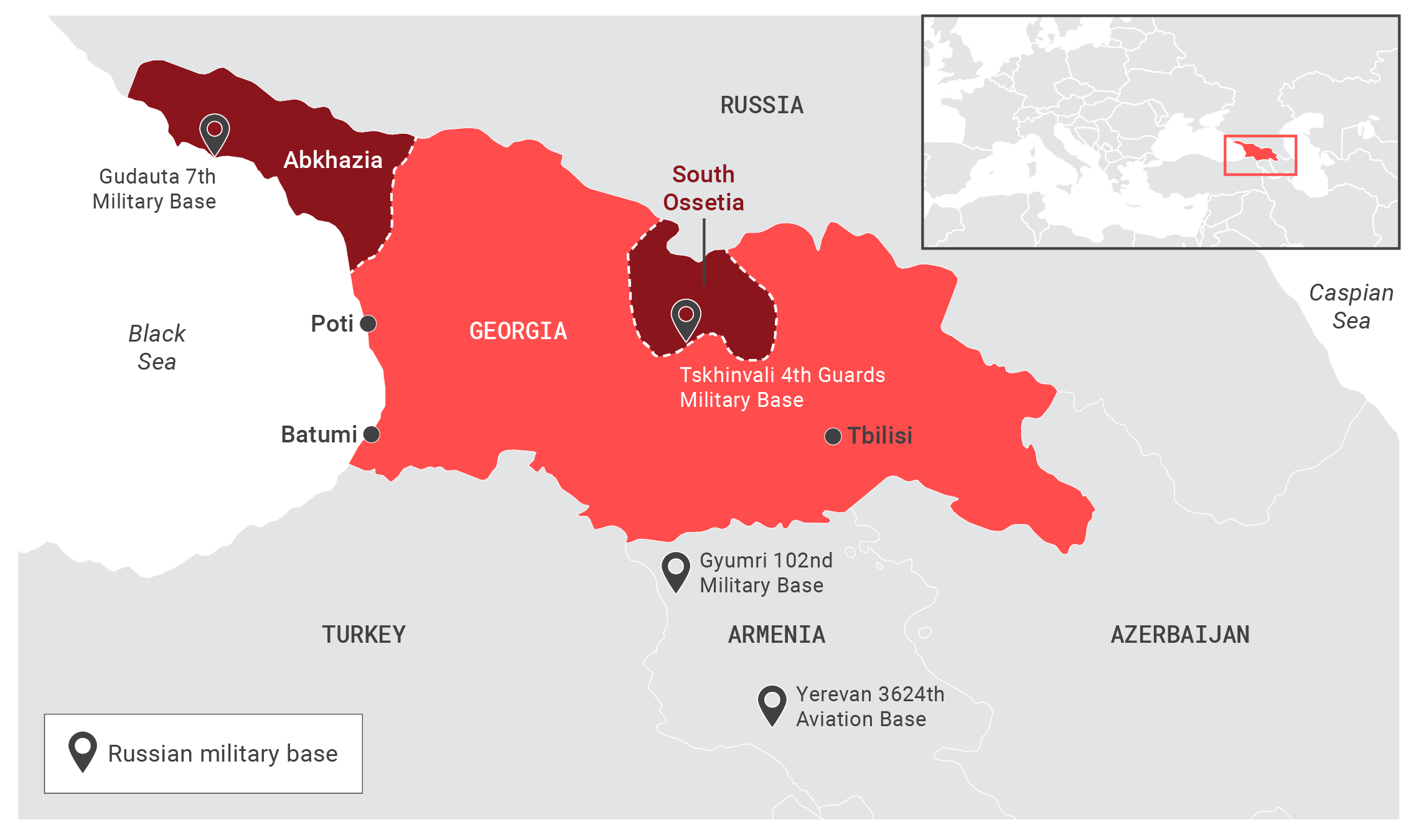
Russia bases military forces not only on Georgian territory (in the separatist republics of Abkhazia and South Ossetia), but also to Georgia’s immediate south in Armenia.
Tbilisi’s inability to exert sovereignty over Abkhazia and South Ossetia might not, in itself, keep Georgia from joining NATO. The alliance’s 1995 Enlargement Study urges aspirant states to commit to resolve any territorial conflicts peacefully, but also notes that there is no hard and fast criteria that must be met; final decisions on new members are ultimately at the alliance’s discretion.5“Study on NATO Enlargement,” North Atlantic Treaty Organization, September 3, 1995, https://www.nato.int/cps/en/natohq/official_texts_24733.htm. Former NATO Secretary General Anders Fogh Rasmussen has suggested that Georgia could join with sovereignty only over part of its lands, drawing an analogy to the admission of West Germany in 1955 despite it not having control over East German territory.6Ani Chkhikvadze, “Former NATO Chief Suggests German Model for Georgia to Join Alliance,” Reuters, September 12, 2019, https://www.voanews.com/europe/former-nato-chief-suggests-german-model-georgia-join-alliance.
But Abkhazia and South Ossetia do factor prominently into questions about Georgia’s overall defensibility. In 2008, Georgia tried to force the question of their status, launching an offensive against the South Ossetian capital, Tskhinvali. The ensuing five-day conflict, popularly known as the August War, was brief but brutal.7Anton Lavrov, “Timeline of Russian-Georgian Hostilities in August 2008,” in ed. Ruslan Pukhov, The Tanks of August (Moscow: Centre for Analysis of Strategies and Technologies, 2010): 37–75. The clear loser was Georgia, with consequences for its security situation that remain relevant to this day.
The lasting impact of the August War
The August War had four main impacts. First, Georgia lost precious military equipment, not only during the actual conflict but to looting in occupied territory after the fact. Russia confiscated or destroyed thousands of small arms, 20 infantry fighting vehicles, and 65 main battle tanks (MBTs)—a figure equivalent to slightly more than half Georgia’s current inventory of MBTs.8Lavrov, “Timeline of Russian-Georgian Hostilities in August 2008,” 75. In addition, most of Georgia’s naval capacity was destroyed when Russia occupied Poti, Georgia’s primary naval base.9Lavrov, “Timeline of Russian-Georgian Hostilities in August 2008,” 74. Georgian defense budgets—which had soared in the years leading up to the offensive—would drop back to roughly 2 percent of GNP annually, an impressive number for a small country but insufficient to adequately replace the extensive equipment losses of 2008.10“Military Expenditure (% of GDP) – Georgia,” World Bank Open Data, Accessed May 28, 2021, https://data.worldbank.org/indicator/MS.MIL.XPND.GD.ZS?locations=GE.
Second, the war tarnished Georgia’s international image. For most of the 1990s and 2000s, Tbilisi had been something of a Western darling. This was aided initially by the presidency of Eduard Shevardnadze, the former Soviet foreign minister and an essential partner to Mikhail Gorbachev. Despite not governing as a true democrat, Shevardnadze’s personal cache in Western capitals translated into widespread support for Georgia, in terms of both diplomatic favor and financial and military assistance. Even when he was deposed in the 2003 Rose Revolution, the optic of a bloodless, popular uprising was a boon to Georgia’s image and that of its new leader, Mikheil Saakashvili. But the August War altered the perception of Saakashvili dramatically, from one of bold reformer to impetuous gambler.11Gerard Toal, Near Abroad (New York: Oxford University Press, 2017): 93–125.
Third, the conflict allowed the regional governments in Abkhazia and South Ossetia to extend dominion across their territories. (Although Abkhazia was not attacked directly by Georgian forces, Russia used it to open a second front and launch its own strike down the coast to Poti.) Up until that point, portions of the two provinces had been disputed; Georgia’s ill-fated offensive created the opportunity for local militias—with Russian backing—to expand control to their republics’ borders, in some cases expelling ethnic Georgians to do so. A subsequent investigation by the European Union confirmed that South Ossetian militias engaged in ethnic cleansing with the apparent acquiescence of Russian forces.12Marc Champion, “Tbilisi Started ‘08 War, but Moscow Also at Fault, E.U. Finds,” Wall Street Journal, October 1, 2009, https://www.wsj.com/articles/SB125431087432152321.
Launching the Serdyukov reforms
The final consequence of the August War is perhaps the most significant of all: It sparked important reforms in the Russian military that have fundamentally improved its operational effectiveness and overall quality. Unambiguously, Russia won the short conflict. But its performance was lumbering and awkward; it triumphed via shear bulk and brute force, not through any demonstration of operational skill.13Michael Kofman, “Russian Performance in the Russo-Georgian War Revisited,” War on the Rocks, September 4, 2018, https://warontherocks.com/2018/09/russian-performance-in-the-russo-georgian-war-revisited/.
Communication systems were incompatible across different units or simply did not work. Battlefield sensors for targeting over-the-horizon strikes were nonexistent. Worst of all, the Russian military’s constituent services largely conducted their own separate campaigns without any concept of the “jointness” the U.S. military swears by.14Kofman, “Russian Performance in the Russo-Georgian War Revisited.” There is perhaps no more telling fact than Russian air defenses shot down at least as many Russian planes as Georgia did.15Russia lost six aircraft in the brief war. Three appear to have been the victims of friendly fire, while the cause of a fourth’s destruction remains uncertain. Georgia only had two confirmed kills. Anton Lavrov, “Russian Air Losses in the Five Day War Against Georgia,” in Pukhov, The Tanks of August, 99–105.
The Russian military’s poor showing did not initiate calls for reforms so much as validate existing concerns and plans. Russia had been trying to transition away from a conscript force to a professional military since the 1990s with only sporadic progress. Other initiatives, such as consolidating redundant command structures and promoting greater coordination among the services were also unfulfilled priorities for some time.16Charles K. Bartles, “Defense Reforms of Russian Defense Minister Anatolii Serdyukov,” Journal of Slavic Military Studies, vol. 24, no. 1 (2011): 55–56. The 2008 conflict provided the impetus to press ahead with these changes against internal resistance within the armed forces.17Kofman, “Russian Performance in the Russo-Georgian War Revisited.” Known as “the Serdyukov reforms” (after the defense minister at the time), they were accompanied by sustained investments in updated platforms and systems.18For a detailed overview of the reforms themselves, see Bartles, “Defense Reforms of Russian Defense Minister Anatolii Serdyukov,” 55–80. For an analysis of the state armaments programs that accompanied them, see Julian Cooper, Russia’s State Armament Programme to 2020: A Quantitative Assessment of Implementation 2011–2015 (Stockholm: Swedish Defense Research Agency, March 2016), http://dx.doi.org/10.13140/RG.2.1.3859.3685.
The overall result has been a leaner, nimbler military with higher levels of professionalism, modernized equipment, and better integration of cross-service operations. In short, Georgia now faces a far more effective Russian force than that which won awkwardly—yet triumphed nonetheless—in 2008.
The current military situation
The August War took a bad strategic position for Georgia and made it even worse. But even without that conflict, Georgia faced several inherent challenges. These include its small size, its geographic isolation, and the extreme imbalance between its military capabilities and those of Russia. These are largely fixed, unalterable variables. In looking at legitimate options for Georgia’s conventional defense, the prospects are inauspicious.
The absence of strategic depth
One of Georgia’s two fundamental weaknesses is a lack of strategic depth. It simply is not a large country. The distance between its southern and northern frontiers barely reaches 120 miles at any one point, at least in the territory currently controlled by Tbilisi.
The presence of Russian forces in the separatist republics further compromises this vulnerability. Russia has two main installations in each separatist republic, the 7th Military Base at Gudauta, Abkhazia, and the 4th Guards Base at Tskhinvali, South Ossetia. The latter site is a mere 60 miles from Tbilisi. (For comparison purposes, Philadelphia and New York City are about 80 miles apart.) Added to this, Russia also stations forces to Georgia’s immediate south in Armenia: at the 102nd Military Base in Gyumri and at the 3624th Aviation Base, just outside Yerevan.
Russia’s military presence on Georgian territory also solidifies its hold over the Gantiadi-Adler crossing in Abkhazia and the Roki Tunnel in South Ossetia. These are two of only a handful of main transit points across the Greater Caucasus Mountains, the Roki Tunnel being particularly important as the conduit for the Transcaucasian Highway through the range. These crossing points connect Russian forces in occupied Georgian territory with their counterparts to the north and would be the prime channels for additional reinforcements.
Comparison of select ground force equipment

The balance of military forces in the Caucasus does not favor Georgia, with the Southern Military District also able to call on additional reinforcements from elsewhere in Russia if needed.
An overwhelming imbalance of forces
Numerically, there simply is no comparison between Georgia and Russia’s total forces. The latter has a standing military of 900,000 personnel, giving it a staggering 44-to-1 advantage over Georgia, which fields an army of only 20,650.19International Institute for Strategic Studies, “Chapter Five: Russia and Eurasia,” The Military Balance, published online February 24, 2021, https://doi.org/10.1080/04597222.2021.1868794. Of course, this is a crude measure. Russia’s bulk advantage in numbers would never exclusively be focused on Georgia alone; it has eleven time zones to defend and far greater strategic challenges to worry about from NATO to its west and China in the east.
But even if one confines the analysis to local forces, the picture is bleak. Russia deploys its armed forces across five geographic commands that cover the entire country and certain immediate regions outside its borders. For Georgia, the relevant command is the Southern Military District, which has operational control over forces in Russia’s northern Caucasus region, as well as those deployed abroad in Abkhazia, Armenia, Crimea, and South Ossetia.
Just looking at the Southern Military District—without considering additional reinforcements from elsewhere in Russia—Moscow’s forces would enjoy almost a 3-to-1 advantage in armor, an 8-to-1 advantage in armored personnel carriers and infantry fighting vehicles, and a 5-to-1 advantage in self-propelled artillery.20“Chapter Five: Russia and Eurasia,” The Military Balance, and “Table B.2 – Russian Order of Battle, Southern Military District,” in Ben Connable, Abby Doll, Alyssa Demus, Dara Massicot, Clint Reach, Anthony Atler, William Mackenzie, Matthew Povlock, and Lauren Skrabala, Russia’s Limit of Advance: Analysis of Russian Ground Force Deployment Capabilities and Limitations (Santa Monica, CA: RAND Corporation, 2020): 74–76, https://www.rand.org/pubs/research_reports/RR2563.html. Across its three bases in Abkhazia, Armenia, and South Ossetia alone, Russia has the same number of tanks as Georgia does in its total force.21“Chapter Five: Russia and Eurasia,” The Military Balance, 185, and “Table B.2 – Russian Order of Battle, Southern Military District,” in Russia’s Limit of Advance, 74–76. Beyond this, Russia has advanced capabilities that Georgia simply does not, such as theater ballistic missiles. To cite the most pertinent example, Russia deploys three brigades of its most advanced theater missile system, the Iskander, in the Southern Military District.22“Chapter Five: Russia and Eurasia,” The Military Balance, 202.
Russia would dominate at sea and in the air
Russia could also control the seas, moving at will along the Black Sea coast. Georgia never replaced its naval losses from the August War, disbanding its navy completely two months after the conflict.23Vyacheslav Tsuluiko, “Present and Future of the Georgian Russian Military Conflict. The Military Aspect,” in Pukhov, The Tanks of August, 82.
Just as damning, Georgia has an extremely limited ability to contest its own airspace. It effectively has no air force. On paper, it has nine Su-25 aircraft but these are designed for close air support—roughly analogous to the U.S. A-10—not for air supremacy. Worse still, only three are believed to be operational.24“Chapter Five: Russia and Eurasia,” The Military Balance, 185. They might have some minor value in an anti-armor role but would be useless in counteracting Russia’s own aircraft. In contrast, Russia can project significant airpower over Georgian airspace, basing multiple squadrons throughout the Southern Military District, including 18 MiG-29 fighters at its airbase outside Yerevan.25“Chapter Five: Russia and Eurasia,” The Military Balance, 202.
The situation only improves slightly when it comes to air defenses. Georgia has no area-wide air defense system (such as the U.S. Patriot or Russian S-400). It does operate the SA-11 Gadfly medium-range air defense system, which may have been responsible for one of Georgia’s two confirmed air kills in 2008.26Lavrov, “Russian Air Losses in the Five Day War Against Georgia,” 100. But the SA-11 is known to be susceptible to jamming and is a dated system, which Russia itself has replaced with an updated iteration, the SA-17.27Ivan Oelrich, “The Ultimate Guide to the SA-11 Gadfly,” National Interest, July 22, 2014, https://nationalinterest.org/blog/the-buzz/the-ultimate-guide-the-sa-11-gadfly-10928. Beyond the Gadfly, Georgia’s active defenses remain limited to a hodgepodge of French, Israeli, Polish, and Ukrainian short-range and man-portable systems.28For a detailed listing of Georgian short-range and man-portable systems, see “Chapter Five: Russia and Eurasia,” The Military Balance, 185–186.
Perhaps more importantly, Georgian air defenses are compromised by the inherent vulnerability of their sensors. During the August War, Russia used anti-radiation missiles to destroy three Georgian radar sites (with a fourth site demolished by Russian airborne forces when Poti was sacked).29Anton Lavrov, “State of the Georgian Army at the End of Hostilities,” in Pukhov, The Tanks of August, 111. The missile strikes resulted in Georgia switching off additional radars to protect them from attack, leaving its nationwide network largely blinded.30Lavrov, “State of the Georgian Army at the End of Hostilities,” 111. There is no reason to believe this same weakness would not obtain in any future conflict.
Georgia’s advantage: The Greater and Lesser Caucasus
Georgia has one simple advantage: terrain. The country is bracketed by the Greater Caucasus Mountains (in the north) and the Lesser Caucasus Mountains (in the south). Together they form impressive physical barriers to outside invaders. Russia, of course, partially circumvents this by basing forces south of the Greater Caucasus on Georgian territory itself. But, as noted, there are limited crossing points of the Greater Caucasus, which can reach altitudes over 18,000 feet. Those access routes—such as the Roki Tunnel—form potential chokepoints that could be used—in theory—to slow or halt the flow of reinforcements during wartime.
Georgia’s interior is also crossed by a number of minor ranges, including the Likhi Ridge, which links the Greater and Lesser Caucasus, dividing the country into east and west. In the event of occupation, this terrain would be fertile ground for guerilla warfare.
But there are also limits to how much its natural topography can aid Georgia. Despite the preponderance of mountainous terrain, Georgia does feature significant areas of flatlands in the east and west. The most notable of these is the Kolkhida Lowland, a coastal plain that abuts the Black Sea and renders most of the western portion of Georgia open territory. This would facilitate the ability of Russian forces driving south from Abkhazia to cut off Tbilisi and other inner Georgian cities from the sea. The inaccessibility of the Greater and Lesser Caucasus would then work against Georgia, limiting its outside contact once its sea access was lost.
And as formidable as the Greater Caucasus might be, it does not negate Russia’s advantages in the air or at sea. Even if it were denied ground access south, Russia could still conduct strikes at will from ships in the Black Sea or air and missile forces based on its own territory to the north. Expanding its air forces in Armenia would be a third option. There ultimately is no escaping the extreme advantage Russia has in terms of its proximity to Georgia and its ability to operate freely in the commons around much of that small country.
Could NATO defend Georgia conventionally?
Almost certainly, the alliance would need to station ground forces on Georgian territory to mount a credible conventional defense. Ideally, it would also want to balance out Russian dominance in the air by basing both its own aircraft and advanced air defense systems, such as Patriot, in the country. But such deployments would still be at the mercy of Georgia’s extremely limited strategic depth and the incredibly short distance between Russian forces and those defending against them.
There are multiple reasons that NATO has limited itself in permanently basing forces in the Baltic states and, to a lesser extent, Poland. Part of this has to do with sensitivity to Russian concerns regarding encroachment. But there also is the fundamental fact that basing high-value platforms—particularly tactical air assets—so close to Russia exposes them to no-warning, surprise attack by missile and air strikes or even ground forces.31On the challenges to forward basing of NATO air assets in the Baltic region, see Ralph S. Clem, “Geopolitics and Planning for a High-End Fight: NATO and the Baltic Region,” Air & Space Power Journal, vol. 30, no.1 (Spring 2016): 74–85, https://www.airuniversity.af.edu/Portals/10/ASPJ/journals/Volume-30_Issue-1/V-Clem.pdf. Yet in the Georgian case, there would be almost no alternative but to station key fighting capabilities where they would be vulnerable to precisely such point-blank attacks. Secure airfields would be at a premium for NATO, particularly if Turkey is not a reliable option for additional basing
Geographic dependence on Turkey
This point highlights Georgia’s second fundamental weakness: complete geographic dependence on Turkey. If Ankara were an unquestioningly steadfast partner, defending Georgia becomes much more plausible, if still far from a certainty. For example, NATO air assets could be based in northeast Anatolia outside the range of Russian missile and artillery systems. Fewer ground forces could be based in Georgia itself, if reserves were ready in Turkey to flow across mutual transit points in the Lesser Caucasus. Batumi—Georgia’s second-largest city and main Black Sea port—becomes far more defensible, just ten miles from the Turkish border. Resupply becomes overall less challenging with Ankara’s dependable support.
But Turkey simply is not reliable, either as a U.S. ally or a NATO member. In fact, more than a few commentators have opined that the alliance should consider suspending or expelling Turkey in recent years, despite the absence of a formal mechanism in the Washington Treaty for doing so.32Daniel R. DePetris, “Sorry, Lindsay Graham: America Can’t Kick Turkey Out of NATO Unilaterally,” National Interest, October 7, 2019, https://nationalinterest.org/blog/skeptics/sorry-lindsey-graham-america-cant-kick-turkey-out-nato-unilaterally-86461; Aurel Sari, “Can Turkey be Expelled from NATO? It’s Legally Possible, Whether or Not Politically Prudent,” Just Security, October 15, 2019, https://www.justsecurity.org/66574/can-turkey-be-expelled-from-nato/.
Under Recep Tayyip Erdogan, Turkey is sometimes said to have taken “a turn” toward Moscow or even Beijing. The reality is more nuanced. Writing recently for Foreign Affairs, Asli Aydintasbas argues that Turkey instead has asserted its role as an independent middle power since the Cold War’s end. Its actions under Erdogan are not symptomatic of realignment against the West so much as evidence of a kind of nonalignment, an assertion of its own separate path.33Asli Aydintasbas, “Turkey Will Not Return to the Western Fold,” Foreign Affairs, May 19, 2021, https://www.foreignaffairs.com/articles/turkey/2021-05-19/turkey-will-not-return-western-fold. From a functional perspective, though, the impact on Turkey’s relationship with NATO is nonetheless the same: It cannot be counted on.
The Montreux Convention and Black Sea access
Turkey also controls access to the Black Sea via the Bosporus and Dardanelle Straits. Transit through the Straits is governed by the 1936 Montreux Convention, which places strict constraints on the quantity and types of military vessels that can enter the Black Sea. States not resident to the sea’s littoral are limited in terms of warship displacement to no more than 30,000 aggregate tons at any one time.34“Implementation of the Montreux Convention,” Republic of Turkey Ministry of Foreign Affairs, Accessed May 29, 2021. https://www.mfa.gov.tr/implementation-of-the-montreux-convention.en.mfa. Moreover, while there is robust debate over the Convention’s specific language on the subject, in practice it has been interpreted by Turkey to ban passage through the Straits by all aircraft carriers and submarines from non-littoral states.35“Implementation of the Montreux Convention.”
This is an aspect that’s often overlooked in discussion of U.S. contingency options in the Black Sea. Aircraft carriers—either by size or type—are prohibited from entering that body of water as are other important strikes options, like the U.S. Navy’s Tomahawk-laden Ohio-class nuclear guided-missile submarines (SSGNs). Navy/Marine Corps amphibious assault ships are also disqualified, displacing over 40,000 tons.36“Amphibious Assault Ships – LHD/LHA(R),” U.S. Navy, Accessed May 28, 2021. https://www.navy.mil/Resources/Fact-Files/Display-FactFiles/Article/2169814/amphibious-assault-ships-lhdlhar/.
The most the U.S. could muster in the Black Sea might be perhaps three Arleigh Burke-class destroyers, each of which displace between 8,200 and 9,700 tons depending on specific type.37“Destroyers (DDG 51),” U.S. Navy, Accessed May 28, 2021. https://www.navy.mil/Resources/Fact-Files/Display-FactFiles/Article/2169871/destroyers-ddg/. Three destroyers are far from insignificant, but they hardly replicate the ability of a full carrier group to conduct sustained and repeated strikes, nor would they be nearly enough to halt a determined Russian advance on their own. And in the close confines of the Black Sea, U.S. destroyers could find themselves operating from primarily a defensive stance, given Russian air and missile capabilities in the region.38Jeffrey R. Frost, “How to Fight Like a Small Navy and Win: Developing A Black Sea Strategy,” U.S. Naval Institute Blog, May 28, 2019. https://blog.usni.org/posts/2019/05/28/developing-a-black-sea-strategy.
The Black Sea region and its waterway access via the Turkish Straits
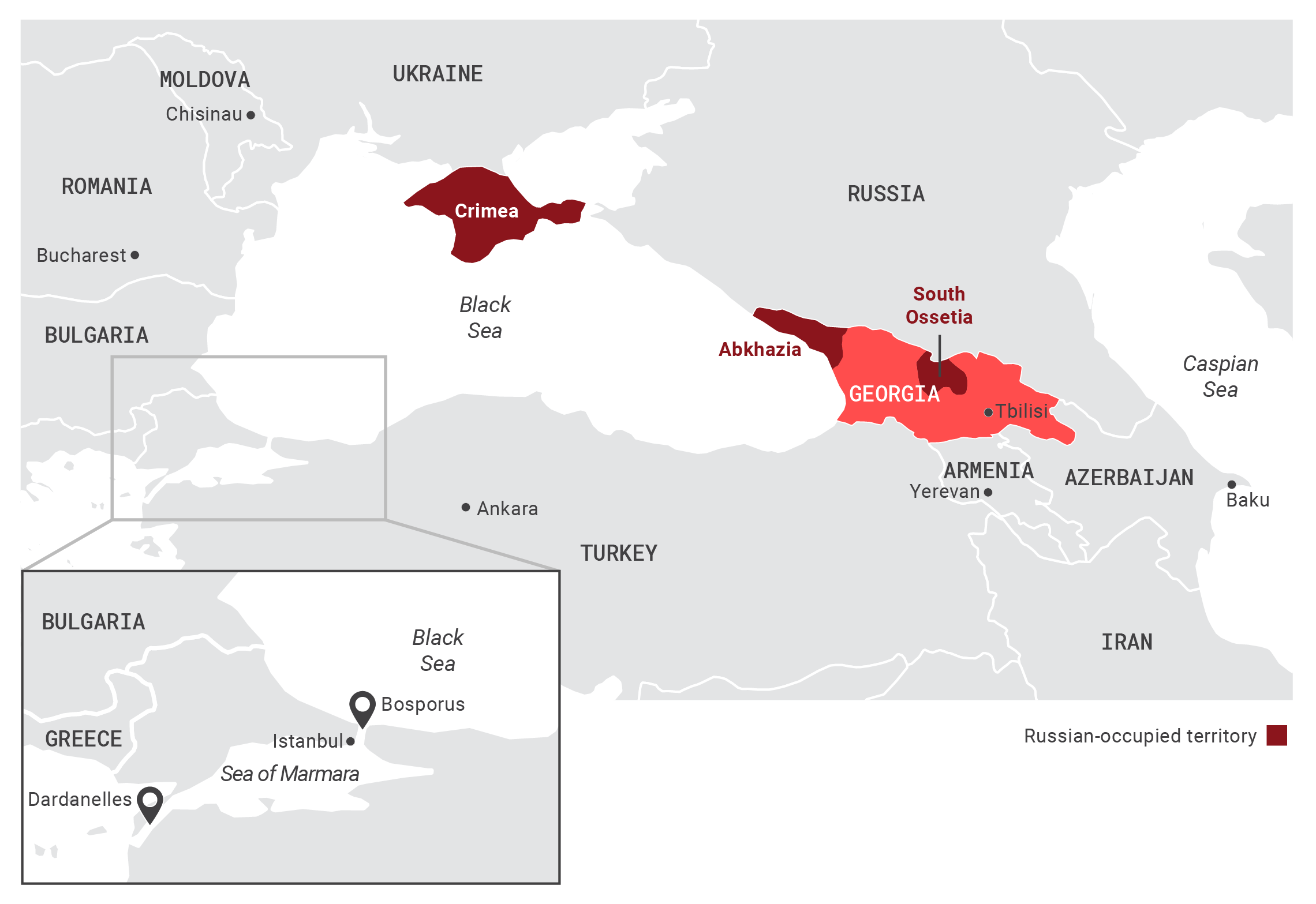
The Montreux Convention, which governs access to the Turkish Straits, limits the size and quantity of military vessels that can enter the Black Sea. This would constrain U.S. and NATO efforts to deploy sizeable naval forces to support Georgia in the event of aggression by Russia.
Of course, U.S. and other NATO naval forces could attempt to launch missile strikes or carrier aircraft from the Mediterranean. But here, too, Turkey’s permission would be essential for overflight of its territory. Under any scenario, allied navies attempting to support Georgia in a war with Russia would be subject to Ankara’s caprice.39Turkey has also announced plans for a canal in western Istanbul that would bypass the Bosporus. Arguably, this new passage would not be subject to the Montreux Convention and would give Turkey even greater latitude in controlling access to the Black Sea if it subsequently decided to shut down commercial and military traffic through the Bosporus. See Paul Pryce, “Let Me Get this Strait: The Turkish Straits Question Revisited,” Center for International Maritime Security, June 1, 2020, https://cimsec.org/let-me-get-this-strait-the-turkish-straits-question-revisited/.
A Romanian option?
NATO’s other options for externally supporting operations in Georgian territory are tenuous. There simply is no other contiguous alliance territory or even member states in the immediate vicinity.
Bulgaria and Romania, 650 miles away across the Black Sea, would be the next-best option, but hardly a desirable one. The U.S. Air Force recently announced plans to invest $152 million in upgrading Romania’s 71st Air Base at Campia Turzii to buttress its regional presence.40Mila Cisneros, “AFIMSC Det. 4, AFCEC Upgrade Infrastructure at Air Base Campia Turzii, Romania,” U.S. Air Force, May 16, 2021, https://www.af.mil/News/Article-Display/Article/2607469/afimsc-det-4-afcec-upgrade-infrastructure-at-air-base-campia-turzii-romania/. But Campia Turzii is located in northwest Romania, some 1,100 miles from Tbilisi (i.e., more than 2,000 miles roundtrip).
Most aircraft in the U.S. and NATO inventory would need to refuel on combat flights from Campia Tuzii to Georgia and also would have to circumvent the increasingly potent air defenses Russia has installed in Crimea since its illegal seizure of the peninsula in 2014.41Michael Petersen, “The Naval Power Shift in the Black Sea,” War on the Rocks, January 29, 2019, https://warontherocks.com/2019/01/the-naval-power-shift-in-the-black-sea/. It is difficult to see how air operations out of Romania on their own could reliably support sustained NATO ground operations during a Georgian conflict.
Does Georgia warrant a U.S. nuclear guarantee?
This returns to an inescapable fact: without Turkish support, Georgia’s defensive position, at least from the perspective of conventional options, would be extraordinarily challenging, if not hopeless. The question asked at the beginning of this paper thus remains: Should the U.S. extend its nuclear umbrella to Georgia? There would appear to be no grounds for arguing yes. Looked at dispassionately, there is nothing Georgia offers from the standpoint of U.S. interests that would warrant the risks of a formal commitment to defend the country.
Georgia is important as a conduit for energy out of the Caspian Basin, hosting two main oil pipelines, one to the Black Sea and a second continuing through Turkey to the Mediterranean.42The Western Route Export Pipeline runs from Baku, Azerbaijan to Supsa, Georgia on the Black Sea coast. A second, larger pipeline (known as the “BTC pipeline”) runs from Baku to Tblisi and then on to Ceyhan, Turkey on the Mediterranean. It also is the transit corridor for a major gas line from the Caspian that serves as one leg of an export route to the European Union, known as the Southern Corridor.43The South Caucasus Pipeline carries gas along a route that parallels the BTC oil pipeline up until Erzurum, Turkey, where it connects with two other pipelines to eventually bring gas to southern Europe as far west as Italy. For background on the E.U.’s Southern Corridor, see Lee Morrison, “Southern Gas Corridor: The Geopolitical and Geo-Economic Implications of an Energy Mega-Project,” Journal of Energy and Development, vol. 43, no. 1/2 (Autumn 2017/Spring 2018): 251–291, https://www.jstor.org/stable/10.2307/26539576. But none of these is even remotely important to U.S. supply needs.44From 2015 to 2020, for example, U.S. oil imports from the Caspian’s littoral states were either negligible or nonexistent in some years. There were also no gas imports from the region at all during this period. See “U.S. Imports by Country of Origin,” Petroleum & Other Liquids, U.S. Energy Information Administration, Accessed May 30, 2021, https://www.eia.gov/dnav/pet/pet_move_impcus_a2_nus_ep00_im0_mbbl_a.htm; “U.S. Natural Gas Imports by Country,” Natural Gas, U.S. Energy Information Administration, Accessed May 30, 2021, https://www.eia.gov/dnav/ng/NG_MOVE_IMPC_S1_A.htm.
An argument could conceivably be made that Georgia’s territory itself might be a strategic asset. In 2011, for example, a group of U.S. senators proposed basing a powerful AN/TYP-2 X-band radar in Georgia when Turkey initially balked at hosting the system.45Josh Rogin, “Senators Call for NATO Missile Defense in Georgia,” Foreign Policy, February 3, 2011, https://foreignpolicy.com/2011/02/03/senators-call-for-nato-missile-defense-in-georgia/. Although Ankara eventually relented on the issue, Erdogan has repeatedly threatened to shut down the radar site, leading to ongoing questions about alternate locations.46In 2019, for example, Erdogan suggested he could shut down the AN/TPY-2 based at Kurecik as well as air operations at Incirlik as part of the ongoing rift with the alliance over Turkey’s purchase of the Russian S-400 air defense system. Selcan Hacaoglu, “Erdogan Drags NATO Bases into Row Over Russian Missile Deal,” BloombergQuint, Updated December 17, 2019. https://www.bloombergquint.com/markets/erdogan-warns-turkey-may-shut-down-key-nato-air-base-and-radar. Situated in the Georgian mountains, an X-band radar would afford good coverage of Iran for cuing NATO missile defenses.
But doubtless the deployment of such a powerful sensor on Russia’s southern border would trip concerns in Moscow—much as the deployment of an AN/TYP-2 in South Korea angered China in 2016, even as that radar was focused on North Korea.47The AN/TPY-2 was deployed to South Korea to support the U.S. Terminal High Altitude Air Defense (THAAD) system. For an overview of China’s concerns about the X-band radar, see Ankit Panda, “THAAD and China’s Nuclear Second-Strike Capability,” Diplomat, March 8, 2017, https://thediplomat.com/2017/03/thaad-and-chinas-nuclear-second-strike-capability/, and Ankit Panda, “Ex-CIA Director’s Take on THAAD in South Korea Will Vindicate China’s Skepticism,” Diplomat, March 8, 2017, https://thediplomat.com/2017/04/ex-cia-directors-take-on-thaad-in-south-korea-will-vindicate-chinas-skepticism/. This example points out a fundamental conundrum: Anything the United States or NATO could base on Georgian territory—including the forces necessary to defend the tiny country—are likely to be viewed as a threat by Russia and perhaps prompt the very attack alliance membership is designed to prevent.
Outside of those considerations, it is difficult to make a sound argument for Georgia’s strategic value. Sadly, even the moral aspect of fraternity with another democracy does not enter the equation. Georgia never fulfilled the promise of the Rose Revolution and has failed to move beyond its status as a “transitional regime” from the standpoint of democratization.48“Transitional or hybrid regime” is Georgia’s most recent status under the Freedom House Democracy Index, although that entry appears to predate the arrest of Nika Melia. See Nino Gozalishvili, “Georgia,” Nations in Transit 2021, Freedom House, Accessed May 28, 2021, https://freedomhouse.org/country/georgia/nations-transit/2021. Events earlier this year—including the arrest of opposition leader Nika Melia by a SWAT team storming his party offices—suggest that Georgia is not moving in the right direction.49Andrew E. Kramer, “Arrest of Opposition Leader in Georgia Raises Fear of Growing Instability,” New York Times, Updated February 27, 2021, https://www.nytimes.com/2021/02/24/world/europe/georgia-opposition-leader-arrest.html. For additional background on the political crisis surrounding Melia’s arrest, see Teona Zurabashvili, “Understand Georgia’s Current Political Situation,” New Europe, Updated February 26, 2021, https://www.neweurope.eu/article/understanding-georgias-current-political-situation/.
The United States’ interests, not Russia’s veto
Advocates of Georgian membership in NATO argue that Moscow should not be given a veto over the matter. This is a fair point. Georgia is a sovereign state that should be able to make decisions about how to conduct its foreign and defense policies. But so, too, is the United States. It is not compelled to take on a commitment that would present a formidable conventional defensive challenge or that would necessitate a questionable extension of its nuclear umbrella. Certainly, it is not required to do these things for a country which does not constitute a core U.S. interest.
Another line of argument holds that the United States and NATO already run nuclear risks in the Baltic states, where conventional defense is a similarly dubious proposition.50For more on the risks of nuclear use in Baltic scenarios, see Mike Sweeney, “Reconsidering U.S. Nuclear Weapons in Europe,” Defense Priorities, September 2020, https://www.defensepriorities.org/explainers/reconsidering-us-nuclear-weapons-in-europe. This is another point worth considering. But the simple fact is Estonia, Latvia, and Lithuania were admitted into the alliance 17 years ago under different strategic circumstances, at a time of Russian military and political weakness. The ensuing nuclear risk that developed on NATO’s northeastern flank should feed the robust debate on the costs and benefits of that round of enlargement, not serve as an example for wantonly creating a similar danger on the alliance’s southeastern flank.51In the Baltic case there also is at least some prospect of conventional defense due to their land connection to Poland, one of the alliance’s most committed military members and a gateway to the bulk of the alliance’s fighting power in Europe. Turkey, again, is a very different case and without its guaranteed support, Georgia would be essentially an isolated island on the alliance’s far-flung periphery.
If Georgia was truly vital to U.S. security—as, for example, West Germany was during the Cold War—it might accept the significant risks involved in defending it, to include a nuclear guarantee. But Georgia simply does not meet that criterion. This will no doubt be an unsatisfactory answer for tiny Georgia seeking security against powerful Russia. But it is one with which it and the United States should reckon. Prolonging the fiction of eventual Georgian membership in the alliance serves neither party’s interest.
Endnotes
- 1See the exchange beginning at 2:46:30 in U.S. Senate Committee on Foreign Relations, “Secretary of State Confirmation Hearing,” C-SPAN, January 19, 2021, https://www.c-span.org/video/?507953-1/secretary-state-nominee-antony-blinken-testifies-confirmation-hearing.
- 2It has been standing U.S. and NATO policy that Georgia will join the alliance since the 2008 Bucharest Summit, though a timetable has never been established and Georgia has never been issued a Membership Action Plan (MAP), i.e., a specific technical roadmap for joining NATO. North Atlantic Treaty Organization, “Bucharest Summit Declaration,” Issued by the Heads of State and Government participating in the meeting of the North Atlantic Council in Bucharest on April 3, 2008, https://www.nato.int/cps/en/natolive/official_texts_8443.htm.
- 3“Can Saakashvili Repeat Adjar Success?” Radio Free Europe/Radio Liberty, May 25, 2004, https://pressroom.rferl.org/a/1105704.html; Nick Paton Walsh and Natalia Antelava, “Adzharian Leader Flees Georgia, Says President,” The Guardian, May 5, 2004, https://www.theguardian.com/world/2004/may/06/georgia.nickpatonwalsh.
- 4In the case of South Ossetia, its separatist movement had sparked a military response from Tbilisi even before the final Soviet collapse. The two sides fought a brutal but inconclusive war from 1991 to 1992. Abkhazia asserted its independence shortly after the fall of the USSR, leading to the 1992–93 Abkhaz-Georgian war.
- 5“Study on NATO Enlargement,” North Atlantic Treaty Organization, September 3, 1995, https://www.nato.int/cps/en/natohq/official_texts_24733.htm.
- 6Ani Chkhikvadze, “Former NATO Chief Suggests German Model for Georgia to Join Alliance,” Reuters, September 12, 2019, https://www.voanews.com/europe/former-nato-chief-suggests-german-model-georgia-join-alliance.
- 7Anton Lavrov, “Timeline of Russian-Georgian Hostilities in August 2008,” in ed. Ruslan Pukhov, The Tanks of August (Moscow: Centre for Analysis of Strategies and Technologies, 2010): 37–75.
- 8Lavrov, “Timeline of Russian-Georgian Hostilities in August 2008,” 75.
- 9Lavrov, “Timeline of Russian-Georgian Hostilities in August 2008,” 74.
- 10“Military Expenditure (% of GDP) – Georgia,” World Bank Open Data, Accessed May 28, 2021, https://data.worldbank.org/indicator/MS.MIL.XPND.GD.ZS?locations=GE.
- 11Gerard Toal, Near Abroad (New York: Oxford University Press, 2017): 93–125.
- 12Marc Champion, “Tbilisi Started ‘08 War, but Moscow Also at Fault, E.U. Finds,” Wall Street Journal, October 1, 2009, https://www.wsj.com/articles/SB125431087432152321.
- 13Michael Kofman, “Russian Performance in the Russo-Georgian War Revisited,” War on the Rocks, September 4, 2018, https://warontherocks.com/2018/09/russian-performance-in-the-russo-georgian-war-revisited/.
- 14Kofman, “Russian Performance in the Russo-Georgian War Revisited.”
- 15Russia lost six aircraft in the brief war. Three appear to have been the victims of friendly fire, while the cause of a fourth’s destruction remains uncertain. Georgia only had two confirmed kills. Anton Lavrov, “Russian Air Losses in the Five Day War Against Georgia,” in Pukhov, The Tanks of August, 99–105.
- 16Charles K. Bartles, “Defense Reforms of Russian Defense Minister Anatolii Serdyukov,” Journal of Slavic Military Studies, vol. 24, no. 1 (2011): 55–56.
- 17Kofman, “Russian Performance in the Russo-Georgian War Revisited.”
- 18For a detailed overview of the reforms themselves, see Bartles, “Defense Reforms of Russian Defense Minister Anatolii Serdyukov,” 55–80. For an analysis of the state armaments programs that accompanied them, see Julian Cooper, Russia’s State Armament Programme to 2020: A Quantitative Assessment of Implementation 2011–2015 (Stockholm: Swedish Defense Research Agency, March 2016), http://dx.doi.org/10.13140/RG.2.1.3859.3685.
- 19International Institute for Strategic Studies, “Chapter Five: Russia and Eurasia,” The Military Balance, published online February 24, 2021, https://doi.org/10.1080/04597222.2021.1868794.
- 20“Chapter Five: Russia and Eurasia,” The Military Balance, and “Table B.2 – Russian Order of Battle, Southern Military District,” in Ben Connable, Abby Doll, Alyssa Demus, Dara Massicot, Clint Reach, Anthony Atler, William Mackenzie, Matthew Povlock, and Lauren Skrabala, Russia’s Limit of Advance: Analysis of Russian Ground Force Deployment Capabilities and Limitations (Santa Monica, CA: RAND Corporation, 2020): 74–76, https://www.rand.org/pubs/research_reports/RR2563.html.
- 21“Chapter Five: Russia and Eurasia,” The Military Balance, 185, and “Table B.2 – Russian Order of Battle, Southern Military District,” in Russia’s Limit of Advance, 74–76.
- 22“Chapter Five: Russia and Eurasia,” The Military Balance, 202.
- 23Vyacheslav Tsuluiko, “Present and Future of the Georgian Russian Military Conflict. The Military Aspect,” in Pukhov, The Tanks of August, 82.
- 24“Chapter Five: Russia and Eurasia,” The Military Balance, 185.
- 25“Chapter Five: Russia and Eurasia,” The Military Balance, 202.
- 26Lavrov, “Russian Air Losses in the Five Day War Against Georgia,” 100.
- 27Ivan Oelrich, “The Ultimate Guide to the SA-11 Gadfly,” National Interest, July 22, 2014, https://nationalinterest.org/blog/the-buzz/the-ultimate-guide-the-sa-11-gadfly-10928.
- 28For a detailed listing of Georgian short-range and man-portable systems, see “Chapter Five: Russia and Eurasia,” The Military Balance, 185–186.
- 29Anton Lavrov, “State of the Georgian Army at the End of Hostilities,” in Pukhov, The Tanks of August, 111.
- 30Lavrov, “State of the Georgian Army at the End of Hostilities,” 111.
- 31On the challenges to forward basing of NATO air assets in the Baltic region, see Ralph S. Clem, “Geopolitics and Planning for a High-End Fight: NATO and the Baltic Region,” Air & Space Power Journal, vol. 30, no.1 (Spring 2016): 74–85, https://www.airuniversity.af.edu/Portals/10/ASPJ/journals/Volume-30_Issue-1/V-Clem.pdf.
- 32Daniel R. DePetris, “Sorry, Lindsay Graham: America Can’t Kick Turkey Out of NATO Unilaterally,” National Interest, October 7, 2019, https://nationalinterest.org/blog/skeptics/sorry-lindsey-graham-america-cant-kick-turkey-out-nato-unilaterally-86461; Aurel Sari, “Can Turkey be Expelled from NATO? It’s Legally Possible, Whether or Not Politically Prudent,” Just Security, October 15, 2019, https://www.justsecurity.org/66574/can-turkey-be-expelled-from-nato/.
- 33Asli Aydintasbas, “Turkey Will Not Return to the Western Fold,” Foreign Affairs, May 19, 2021, https://www.foreignaffairs.com/articles/turkey/2021-05-19/turkey-will-not-return-western-fold.
- 34“Implementation of the Montreux Convention,” Republic of Turkey Ministry of Foreign Affairs, Accessed May 29, 2021. https://www.mfa.gov.tr/implementation-of-the-montreux-convention.en.mfa.
- 35“Implementation of the Montreux Convention.”
- 36“Amphibious Assault Ships – LHD/LHA(R),” U.S. Navy, Accessed May 28, 2021. https://www.navy.mil/Resources/Fact-Files/Display-FactFiles/Article/2169814/amphibious-assault-ships-lhdlhar/.
- 37“Destroyers (DDG 51),” U.S. Navy, Accessed May 28, 2021. https://www.navy.mil/Resources/Fact-Files/Display-FactFiles/Article/2169871/destroyers-ddg/.
- 38Jeffrey R. Frost, “How to Fight Like a Small Navy and Win: Developing A Black Sea Strategy,” U.S. Naval Institute Blog, May 28, 2019. https://blog.usni.org/posts/2019/05/28/developing-a-black-sea-strategy.
- 39Turkey has also announced plans for a canal in western Istanbul that would bypass the Bosporus. Arguably, this new passage would not be subject to the Montreux Convention and would give Turkey even greater latitude in controlling access to the Black Sea if it subsequently decided to shut down commercial and military traffic through the Bosporus. See Paul Pryce, “Let Me Get this Strait: The Turkish Straits Question Revisited,” Center for International Maritime Security, June 1, 2020, https://cimsec.org/let-me-get-this-strait-the-turkish-straits-question-revisited/.
- 40Mila Cisneros, “AFIMSC Det. 4, AFCEC Upgrade Infrastructure at Air Base Campia Turzii, Romania,” U.S. Air Force, May 16, 2021, https://www.af.mil/News/Article-Display/Article/2607469/afimsc-det-4-afcec-upgrade-infrastructure-at-air-base-campia-turzii-romania/.
- 41Michael Petersen, “The Naval Power Shift in the Black Sea,” War on the Rocks, January 29, 2019, https://warontherocks.com/2019/01/the-naval-power-shift-in-the-black-sea/.
- 42The Western Route Export Pipeline runs from Baku, Azerbaijan to Supsa, Georgia on the Black Sea coast. A second, larger pipeline (known as the “BTC pipeline”) runs from Baku to Tblisi and then on to Ceyhan, Turkey on the Mediterranean.
- 43The South Caucasus Pipeline carries gas along a route that parallels the BTC oil pipeline up until Erzurum, Turkey, where it connects with two other pipelines to eventually bring gas to southern Europe as far west as Italy. For background on the E.U.’s Southern Corridor, see Lee Morrison, “Southern Gas Corridor: The Geopolitical and Geo-Economic Implications of an Energy Mega-Project,” Journal of Energy and Development, vol. 43, no. 1/2 (Autumn 2017/Spring 2018): 251–291, https://www.jstor.org/stable/10.2307/26539576.
- 44From 2015 to 2020, for example, U.S. oil imports from the Caspian’s littoral states were either negligible or nonexistent in some years. There were also no gas imports from the region at all during this period. See “U.S. Imports by Country of Origin,” Petroleum & Other Liquids, U.S. Energy Information Administration, Accessed May 30, 2021, https://www.eia.gov/dnav/pet/pet_move_impcus_a2_nus_ep00_im0_mbbl_a.htm; “U.S. Natural Gas Imports by Country,” Natural Gas, U.S. Energy Information Administration, Accessed May 30, 2021, https://www.eia.gov/dnav/ng/NG_MOVE_IMPC_S1_A.htm.
- 45Josh Rogin, “Senators Call for NATO Missile Defense in Georgia,” Foreign Policy, February 3, 2011, https://foreignpolicy.com/2011/02/03/senators-call-for-nato-missile-defense-in-georgia/.
- 46In 2019, for example, Erdogan suggested he could shut down the AN/TPY-2 based at Kurecik as well as air operations at Incirlik as part of the ongoing rift with the alliance over Turkey’s purchase of the Russian S-400 air defense system. Selcan Hacaoglu, “Erdogan Drags NATO Bases into Row Over Russian Missile Deal,” BloombergQuint, Updated December 17, 2019. https://www.bloombergquint.com/markets/erdogan-warns-turkey-may-shut-down-key-nato-air-base-and-radar.
- 47The AN/TPY-2 was deployed to South Korea to support the U.S. Terminal High Altitude Air Defense (THAAD) system. For an overview of China’s concerns about the X-band radar, see Ankit Panda, “THAAD and China’s Nuclear Second-Strike Capability,” Diplomat, March 8, 2017, https://thediplomat.com/2017/03/thaad-and-chinas-nuclear-second-strike-capability/, and Ankit Panda, “Ex-CIA Director’s Take on THAAD in South Korea Will Vindicate China’s Skepticism,” Diplomat, March 8, 2017, https://thediplomat.com/2017/04/ex-cia-directors-take-on-thaad-in-south-korea-will-vindicate-chinas-skepticism/.
- 48“Transitional or hybrid regime” is Georgia’s most recent status under the Freedom House Democracy Index, although that entry appears to predate the arrest of Nika Melia. See Nino Gozalishvili, “Georgia,” Nations in Transit 2021, Freedom House, Accessed May 28, 2021, https://freedomhouse.org/country/georgia/nations-transit/2021.
- 49Andrew E. Kramer, “Arrest of Opposition Leader in Georgia Raises Fear of Growing Instability,” New York Times, Updated February 27, 2021, https://www.nytimes.com/2021/02/24/world/europe/georgia-opposition-leader-arrest.html. For additional background on the political crisis surrounding Melia’s arrest, see Teona Zurabashvili, “Understand Georgia’s Current Political Situation,” New Europe, Updated February 26, 2021, https://www.neweurope.eu/article/understanding-georgias-current-political-situation/.
- 50For more on the risks of nuclear use in Baltic scenarios, see Mike Sweeney, “Reconsidering U.S. Nuclear Weapons in Europe,” Defense Priorities, September 2020, https://www.defensepriorities.org/explainers/reconsidering-us-nuclear-weapons-in-europe.
- 51In the Baltic case there also is at least some prospect of conventional defense due to their land connection to Poland, one of the alliance’s most committed military members and a gateway to the bulk of the alliance’s fighting power in Europe. Turkey, again, is a very different case and without its guaranteed support, Georgia would be essentially an isolated island on the alliance’s far-flung periphery.
More on Eurasia
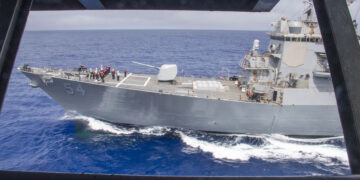
By John Mueller
April 10, 2025
Events on NATO


